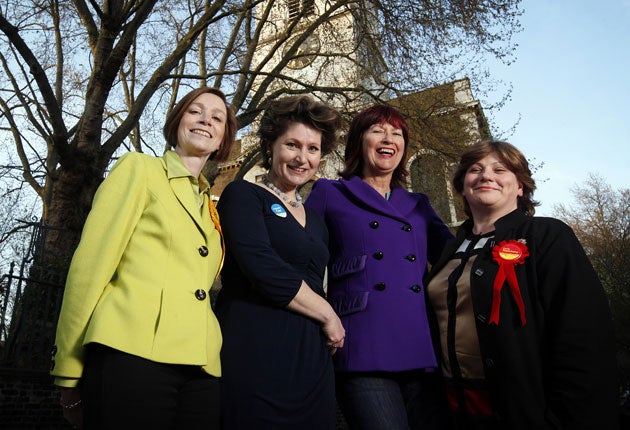Be afraid. Janet's on the stump
In Islington South and Finsbury, former home of Tony Blair, the main parties have all chosen female candidates. Janet Street-Porter met them

Not a day passes without a leaflet dropping through my door urging me to vote – and they're mostly from the Lib Dems. Suddenly, this election has become electrifying: people have been queuing up to register and everyone's talking about the Clegg factor and whether he's heading for burnout. I live in Islington South, formerly the home of the Blair family, and once a Labour stronghold. I say once, because the Labour Party has seen its whopping 1997 majority of 14,563 (62.5 per cent of the vote), when Chris Smith held the seat, dwindle to just 484 and 39.9 per cent of the vote in 2005. That's some slump. And the local council, once solidly Labour, is now equally split between Labour and the Lib Dems, with a Lib Dem mayor. Emily Thornberry, who succeeded Chris Smith in 2005, actually lives in the same posh street as the Blairs before they decamped to Downing Street and even swankier Connaught Square.
I've lived in Islington South since 1986. Since that time Clerkenwell has seen small businesses close as rents soar and buildings are demolished and remodelled as luxury flats. The old craft and engraving workshops have been replaced by the highest concentration of architects and designers offices in London. There are immigrants and the very poor living in social housing alongside the very wealthy in luxury loft conversions and penthouses. I see David Thewlis in Waitrose, and Sam Taylor Wood has her workspace round the corner, next to the Pet Shop Boys' studio. Bankers exist in a parallel world, using fashionable restaurants such as St John, The Zetter, The Modern Pantry and Moro, while kids hang out around late-night grocery stores. The middle classes enjoy a wide range of artistic events at Sadler's Wells, the Almeida Theatre and the Barbican.
Changes in Clerkenwell exactly mirror what's happened to our society during Labour's years. The rich have, quite simply, got richer. The poor are stuck at the bottom with a massive waiting list for housing – over half the residents live in social housing. There's little green space, although the council has spent a lot on improving small parks and playgrounds.
Islington North is a far poorer area and there has been a series of stabbings and murders in the streets near King's Cross. The odd crack addict stumbles along the street in filthy sweat pants, but around here – Barnsbury and Canonbury, for example – there are also dozens of houses worth between £1.5m and £3m. How will these one-time socialists vote, after Iraq, Blair, Afghanistan, the recession? One issue uniting all candidates is the planned closure of the Whittington Hospital, but who shall I vote for? I decide to trail the three female candidates for a day to see how they get on.
Join our commenting forum
Join thought-provoking conversations, follow other Independent readers and see their replies
Comments